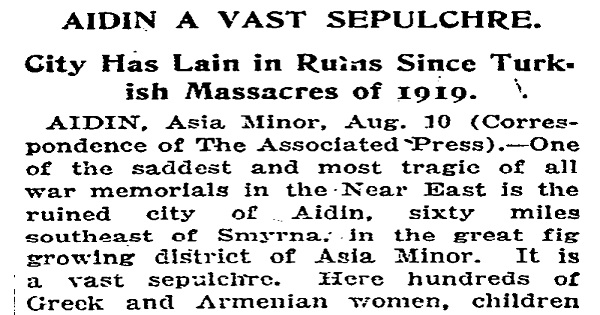AIDIN A VAST SEPULCHRE.
CITY HAS LAIN IN RUINS SINCE TURKISH MASSACRES OF 1919.
The New York Times,
August 29, 1921.
AIDIN, Asia Minor, Aug. 10 (Correspondence of The Associated Press). -One of the saddest and most tragic of all war memorials in the Near East is the ruined city of Aidin, sixty miles southeast of Smyrna, in the great fig growing district of Asia Minor. It is a vast sepulchre. Here hundreds of Greek and Armenian women, children and priests lie in nameless graves – victims of massacres by Turks in the Summer of 1919.
The broken columns of a thousand shattered homes are the mute witnesses of the martyrdom of the population. Although two years have passed since they were sacrificed, no tombstone, no cross, no wreath marks the place where they fell. Their whitening bones form a part of the crumbling masonry and earth. The silence of the place is oppressive.
The town presents an appalling spectacle of desolation and destruction, which has its counterpart only in the ruined cities of France. But here the scene is even more terrible than in the French villages, for in France the populations at least had a chance to escape. In Aidin no such mercy was vouchsafed them. They were slain by the Turks when the Greek army had withdrawn, and many of the victims were burned to death.
In the little Church of the Metropolitan there is still to be seen on the floor grim reminders of the unfortunate priests who were killed and incinerated before the altar. Their blood lies in great congealed patches in the aisles.
A few among the more hopeful and courageous of the population have returned to the desolated city and are living in the ruins of their former homes. Through the dark and debris-strewn alleys, sombre women and girls in mourning move like spectres. All have lost relatives in the massacre. Their faces tell a story of poignant suffering and anguish. Some of them have lost their reason. During his stay in the town the correspondent lived at the home of an aged widow whose three daughters had been slain by the Turks.
A group of Greek Government officials from Athens recently visited Aidin. “We must try to forget the past,” said the Turkish hodja (priest) who came to greet the investigators. “We must be friends. We cannot be enemies. Our religions may be different, but our hearts are the same. We must join hands and hearts and think only of the future.”




